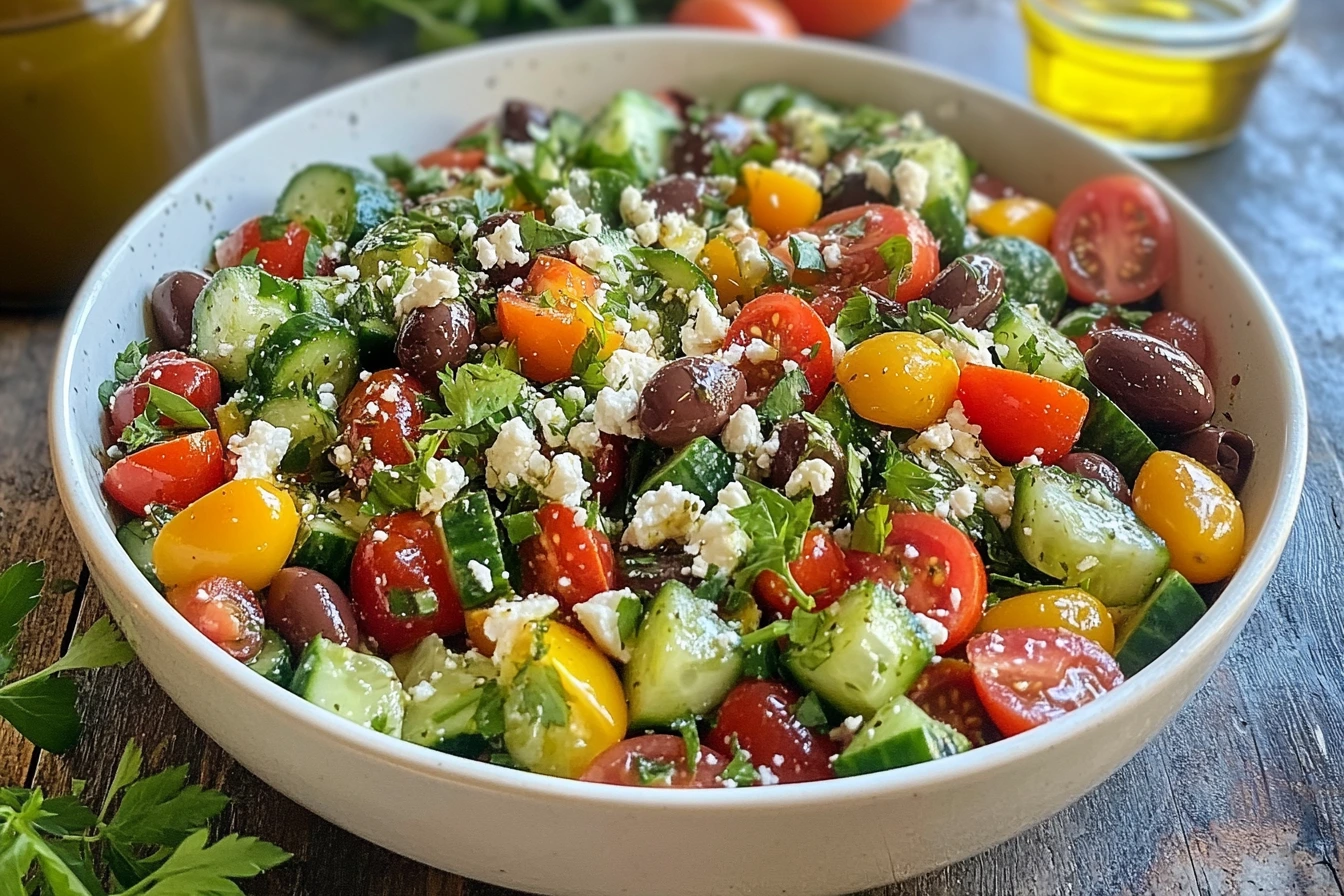Table of Contents
If there’s one dish that perfectly captures the essence of Mediterranean cuisine, it’s a classic Greek salad. When crafted by the iconic Ina Garten, also known as the Barefoot Contessa, this timeless recipe becomes even more special. Known for her effortless approach to gourmet cooking, Ina’s version of the Greek salad is all about fresh, quality ingredients and balanced flavors.
This article will take you on a culinary journey, exploring Ina Garten’s Greek Salad in detail. From its health benefits and ingredient highlights to step-by-step preparation and creative serving ideas, you’ll learn everything you need to recreate this dish at home. Let’s dive in!
The Essence of Greek Salad
What Defines a Traditional Greek Salad?
A traditional Greek salad is a simple yet flavorful dish that embodies the heart of Mediterranean cuisine. At its core, it features a handful of fresh, high-quality ingredients:
- Tomatoes: Juicy and ripe, they serve as the salad’s foundation.
- Cucumbers: Crisp and refreshing, cucumbers add a delightful crunch.
- Red Onions: Thinly sliced for a subtle sharpness that balances the other flavors.
- Kalamata Olives: Their briny taste provides the perfect contrast to the vegetables.
- Feta Cheese: Creamy and tangy, it’s often the star of the dish.
- Olive Oil and Herbs: A drizzle of extra virgin olive oil and a sprinkle of oregano bring everything together.
Interestingly, a true Greek salad doesn’t include lettuce, which is a common addition in American adaptations. Instead, it lets the vibrant ingredients shine, creating a dish that’s as visually appealing as it is delicious.
The Mediterranean Diet and Its Benefits
The Mediterranean diet has gained global recognition for its numerous health benefits, and Greek salad plays a starring role in this way of eating. Here’s why it’s considered a nutritional powerhouse:
- Rich in Healthy Fats: Thanks to olive oil and olives, the salad is packed with monounsaturated fats that support heart health.
- High in Antioxidants: Ingredients like tomatoes and cucumbers are loaded with vitamins and antioxidants that fight inflammation.
- Low in Calories: With its focus on vegetables and light dressing, it’s a satisfying yet low-calorie option.
- Protein from Feta: Feta cheese adds a creamy texture while contributing protein and calcium to the meal.
This combination of flavors and nutrients makes Greek salad not only a delicious dish but also a smart choice for those seeking a balanced diet.
Ina’s Culinary Philosophy
What sets Ina Garten apart is her culinary philosophy, which is beautifully reflected in her Greek salad recipe. At the heart of her cooking is a belief that food should be both delicious and uncomplicated. She emphasizes:
- Quality Over Quantity: Ina believes in using fewer ingredients but ensuring they’re the best you can find. For her Greek salad, this means sourcing ripe tomatoes, crisp cucumbers, and authentic feta cheese.
- Balancing Flavors: Whether it’s the tanginess of feta or the earthiness of oregano, her recipes are a masterclass in harmony.
- Celebrating Simplicity: Ina’s dishes, including her Greek salad, prove that simple recipes can still deliver bold, unforgettable flavors.
Her approach resonates with those who value great food without unnecessary fuss. Moreover, her attention to detail ensures that even novice cooks feel confident tackling her recipes.
How to make Ina Garten’s Greek Salad Recipe?
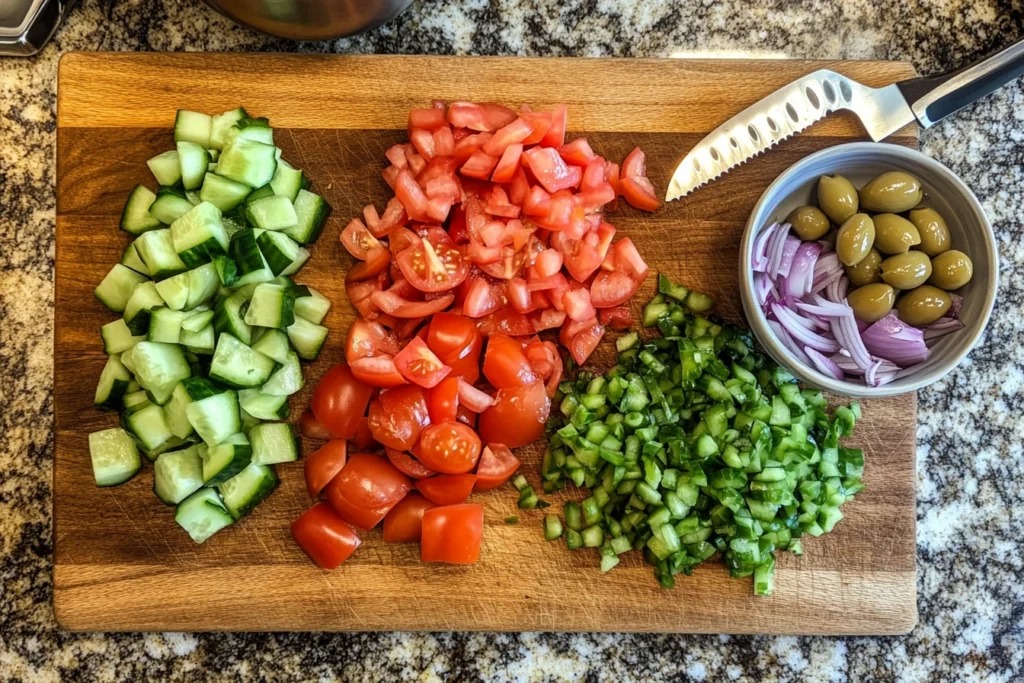
Ingredients Breakdown
Ina Garten’s Greek salad recipe is a testament to her philosophy of using fresh, high-quality ingredients. Here’s what you’ll need to recreate this Mediterranean delight:
- Tomatoes: Choose ripe, juicy tomatoes for the best flavor. Cherry tomatoes are an excellent option if you prefer a sweeter, more concentrated taste.
- Cucumbers: English cucumbers are ideal because of their thin skin and minimal seeds, but any variety will do in a pinch.
- Red Onion: Sliced thinly, red onion adds a sharp, slightly sweet contrast to the other ingredients. To mellow its flavor, soak the slices in cold water for a few minutes before adding them to the salad.
- Kalamata Olives: These briny, dark purple olives are a must for authentic Greek flavor. Be sure to choose pitted ones for convenience.
- Feta Cheese: Ina recommends using a block of feta, crumbled by hand, rather than pre-crumbled versions. This ensures a fresher taste and creamier texture.
- Green Bell Pepper: This addition brings a subtle crunch and a slightly bitter note that complements the other vegetables beautifully.
- Herbs: Fresh oregano and parsley add an earthy, aromatic touch that ties the ingredients together.
- Dressing: A simple vinaigrette made with extra virgin olive oil, red wine vinegar, garlic, and Dijon mustard elevates the dish without overpowering it.
Step-by-Step Preparation
With just a few simple steps, you’ll have a dish that’s bursting with fresh flavors and vibrant colors. Let’s walk through the process step by step:

- Prepare the Vegetables
First and foremost, you’ll need to get your vegetables ready. Start by chopping the tomatoes, cucumbers, and green bell pepper into bite-sized pieces to ensure every forkful offers a perfect blend of flavors. Then, thinly slice the red onion, and for an extra layer of finesse, soak the slices in cold water for about 10 minutes. This quick step softens the onion’s sharpness, making it milder and more balanced. - Combine the Ingredients
Once your vegetables are prepped, it’s time to assemble the salad. In a large salad bowl, mix the tomatoes, cucumbers, bell pepper, and soaked onion slices with the Kalamata olives. Next, take a block of feta cheese and crumble it over the top. Make sure to distribute it evenly so every bite gets a hint of that creamy, tangy goodness. - Make the Dressing
Now comes the part that ties everything together: the vinaigrette. In a small bowl, whisk together the olive oil, red wine vinegar, minced garlic, Dijon mustard, and a pinch of salt and pepper. Be sure to taste the dressing as you go, adjusting the seasoning to suit your preferences. - Toss the Salad
After your dressing is ready, drizzle it generously over the salad. Gently toss everything together to ensure the dressing coats all the ingredients evenly. However, take care not to overmix—the feta should remain intact, adding both texture and visual appeal to the dish. - Add the Herbs
Finally, it’s time for the finishing touch. Sprinkle freshly chopped oregano and parsley over the salad. Not only do these herbs add a burst of color, but they also elevate the flavors with their bright, earthy notes.
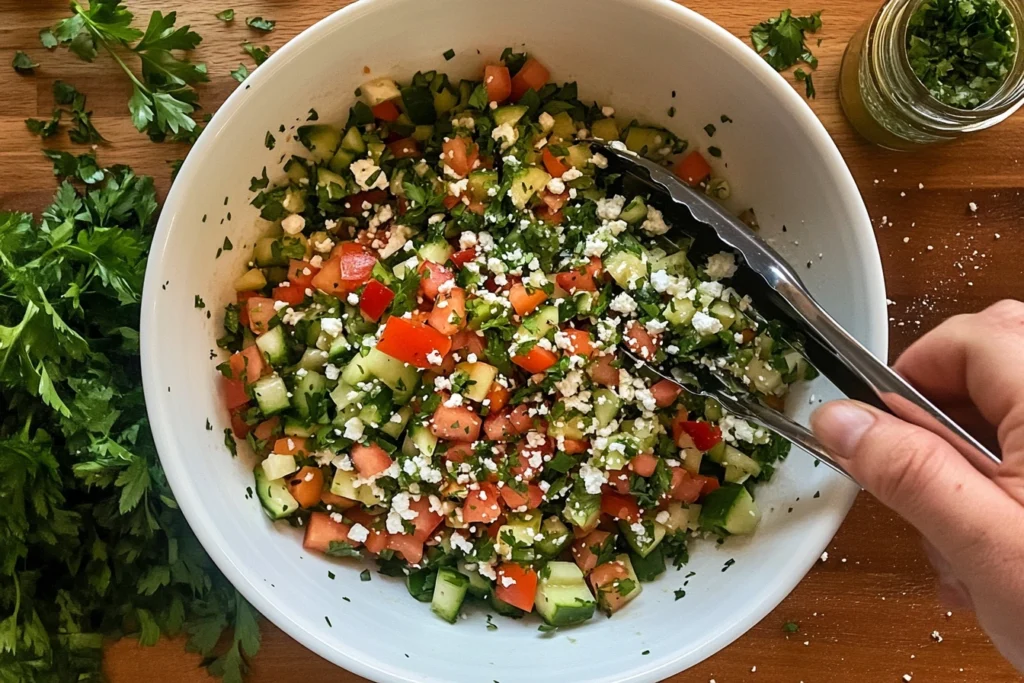
The Signature Vinaigrette
What truly sets Ina Garten’s Greek salad apart from the rest is her perfectly balanced vinaigrette. This dressing is a harmonious blend of tangy red wine vinegar, rich olive oil, and the subtle savoriness of Dijon mustard. To take it a step further, Ina adds a touch of minced garlic, which deepens the flavor without overpowering the delicate balance of the salad.
For an even more polished result, whisk the dressing vigorously until it emulsifies into a silky texture. This extra step not only enhances the dressing’s appearance but also ensures it clings to every ingredient, providing consistent flavor in every bite.
By following these steps, you’ll be well on your way to recreating Ina Garten’s iconic Greek salad—a dish that’s both simple to prepare and unforgettable to taste.
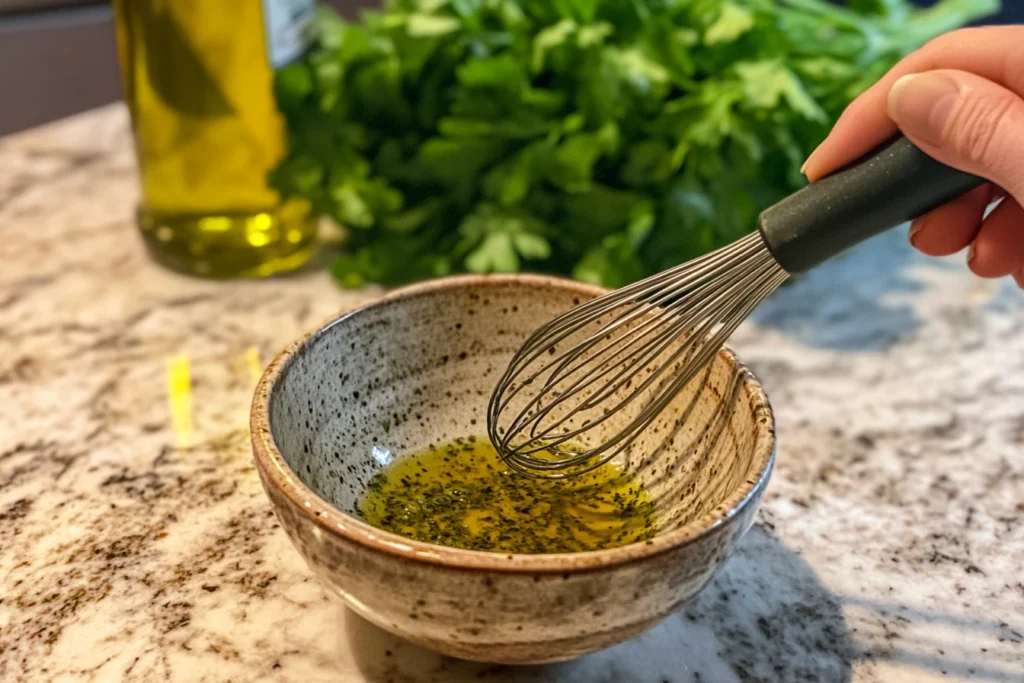
Pro Tip:
For a creamier vinaigrette, whisk the dressing vigorously until it emulsifies. If you prefer a lighter touch, drizzle it over the salad just before serving, rather than tossing it in.
Serving Suggestions
Pairing with Main Dishes
One of the many wonderful things about Ina Garten’s Greek salad is its incredible versatility. It pairs effortlessly with a variety of main dishes, transforming even the simplest meals into something truly special. Whether you’re hosting a dinner party or preparing a casual weeknight dinner, this salad works beautifully in any setting. Here are a few ideas to inspire your next pairing:
- Grilled Chicken or Fish
First and foremost, Greek salad is a natural companion to grilled meats, especially chicken or fish. The salad’s fresh, tangy flavors perfectly complement the smoky, savory notes of grilled chicken breasts or fish fillets like salmon or halibut. Together, they create a light yet deeply satisfying meal that feels both wholesome and indulgent - Vegetarian Dishes
If you’re leaning towards a vegetarian option, the salad pairs seamlessly with dishes like stuffed bell peppers, spanakopita, or a hearty lentil soup. These combinations are not only satisfying but also full of complementary flavors and textures. The salad’s bright acidity brings a refreshing counterpoint to the richness of these vegetarian classics, ensuring every bite feels balanced and flavorful.
Wine Pairings
Of course, no Mediterranean meal would be complete without the perfect wine pairing to elevate the experience. Consider these options for an ideal pairing:
Sauvignon Blanc
A chilled glass of Sauvignon Blanc is an excellent match, thanks to its vibrant citrus notes and refreshing acidity. This wine enhances the salad’s fresh vegetables and vinaigrette while cleansing the palate with each sip.
Alternatively, if you prefer a non-alcoholic option, a glass of sparkling water with a squeeze of fresh lemon or lime pairs equally well, adding a refreshing and zesty touch to your meal.
By thoughtfully pairing Ina Garten’s Greek salad with the right main dishes and beverages, you can elevate any occasion into something truly memorable. Whether you’re entertaining guests or enjoying a quiet meal at home, these pairings ensure every bite and sip feels like a Mediterranean getaway.sh. Here are a few recommendations:
- Sauvignon Blanc: With its citrusy notes and vibrant acidity, Sauvignon Blanc enhances the freshness of the vegetables and vinaigrette.
- Rosé: A dry rosé complements the saltiness of the feta and olives while adding a touch of fruitiness.
- Assyrtiko: This Greek white wine is a natural choice, offering minerality and acidity that pair beautifully with the salad’s flavors.
If you prefer non-alcoholic options, sparkling water with a squeeze of lemon or lime is an equally refreshing choice.
Why Serving Style Matters
How you serve your Greek salad can elevate the entire dining experience. Whether it’s part of a casual family dinner or a sophisticated dinner party, thoughtful pairings and presentation ensure the dish shines in any setting.
Nutritional Information
Health Benefits of Ina Garten’s Greek Salad
One of the reasons Ina Garten’s Greek salad is such a standout dish is its impressive nutritional profile. Not only is it packed with fresh vegetables, but it also includes healthy fats and essential vitamins. Here’s a closer look at the health benefits of its key ingredients:
- Tomatoes: Loaded with lycopene, an antioxidant linked to heart health, tomatoes also provide a dose of vitamin C and potassium.
- Cucumbers: Hydrating and low in calories, cucumbers are rich in fiber and vitamin K, supporting digestion and bone health.
- Red Onions: These add not just flavor but also quercetin, a powerful antioxidant known for its anti-inflammatory properties.
- Feta Cheese: While it’s best enjoyed in moderation, feta cheese provides calcium and protein, along with beneficial probiotics that support gut health.
- Olives and Olive Oil: These are key sources of heart-healthy monounsaturated fats and polyphenols, which can help reduce inflammation.
Together, these ingredients create a dish that’s both delicious and incredibly nourishing.
Caloric Breakdown
While Greek salad is generally considered a light dish, its calorie count can vary based on portion sizes and dressing amounts. Below is an estimated caloric breakdown per serving:
| Component | Calories per Serving | Nutritional Highlights |
|---|---|---|
| Tomatoes | ~25 kcal | Vitamin C, potassium, lycopene |
| Cucumbers | ~16 kcal | Vitamin K, hydration |
| Red Onion | ~15 kcal | Antioxidants (quercetin) |
| Feta Cheese | ~75 kcal | Calcium, protein, probiotics |
| Olives | ~50 kcal | Healthy fats, polyphenols |
| Olive Oil (Dressing) | ~120 kcal | Monounsaturated fats, vitamin E |
Total per Serving: Approximately 300–350 kcal, depending on dressing quantity.
Why It’s a Healthy Choice
What sets this salad apart from many other dishes is its ability to combine indulgence with health benefits. It’s:
- Low in Processed Ingredients: Every component is fresh and minimally processed.
- Rich in Nutrients: Packed with vitamins, minerals, and antioxidants that support overall health.
- Heart-Healthy: Thanks to the olive oil and olives, it’s great for cardiovascular health.
By choosing a dish like this, you’re not just enjoying a meal—you’re fueling your body with ingredients that promote wellness.
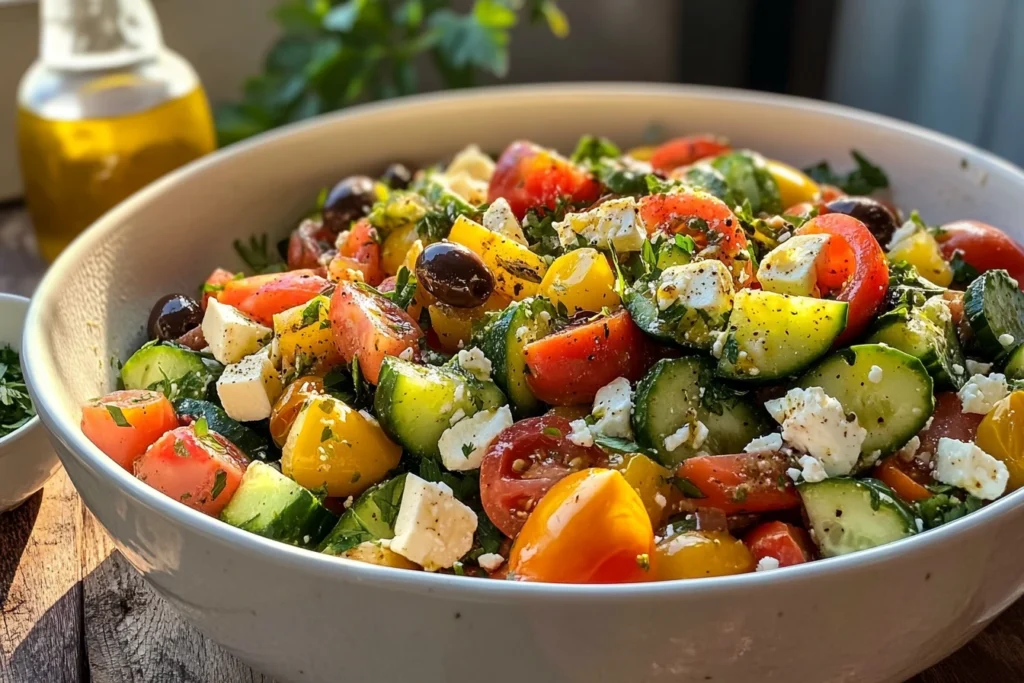
FAQs About Ina Garten’s Greek Salad
What makes Ina Garten’s Greek Salad unique?
Ina Garten’s Greek salad stands out because of her meticulous attention to detail and emphasis on quality ingredients. For instance, she insists on using a block of feta cheese instead of pre-crumbled feta. Why? Because the block retains its creaminess and flavor far better. Furthermore, her signature vinaigrette, with its perfect balance of tangy and savory flavors, elevates the salad without overwhelming the fresh vegetables
How to make greek yogurt?
Making Greek yogurt at home is surprisingly easy and requires just two ingredients: milk and a yogurt starter. With a few simple steps like heating, culturing, and straining, you can create creamy, protein-rich yogurt right in your kitchen. Check out our detailed guide on how to make Greek yogurt for step-by-step instructions and tips to perfect your batch!”
Why does Ina Garten’s recipe include bell peppers?
Unlike some traditional Greek salad recipes, Ina Garten’s version includes green bell peppers. This addition provides a subtle crunch and a slightly bitter note that balances the sweetness of the tomatoes and the saltiness of the feta. It’s a small but thoughtful twist that enhances the overall flavor profile.
Why include Greek Salad in your diet?
Finally, one of the most frequently asked questions is about why this salad should become a regular part of your diet. The answer is simple: it’s a wholesome, nutrient-dense dish that offers an incredible balance of flavor and health benefits. Whether you’re following a Mediterranean diet, looking for a light lunch, or hosting a dinner party, this salad fits perfectly into any scenario. Check out our Mediterranean lunch recipes.
Conclusion
In the end, Ina Garten’s Greek Salad is so much more than just a simple dish—it’s a celebration of fresh, wholesome ingredients and balanced flavors. By combining crisp vegetables, creamy feta cheese, briny olives, and her signature vinaigrette, Ina has crafted a recipe that’s as delicious as it is versatile. Whether you’re preparing a quick lunch, serving it as a side dish, or making it the star of a Mediterranean feast, this salad never fails to impress.
Furthermore, the health benefits of this salad make it an easy choice for anyone aiming to eat well without sacrificing flavor. With its abundance of antioxidants, healthy fats, and essential nutrients, it’s a dish that fuels your body while delighting your taste buds. Plus, the simplicity of the preparation means you can recreate this recipe in your own kitchen with minimal effort.
What’s more, Ina Garten’s thoughtful twists—like the inclusion of green bell peppers and her expertly balanced vinaigrette—elevate this salad into something truly special. And with so many ways to customize it, from adding proteins to pairing it with complementary dishes, the possibilities are endless.
So why not give it a try? Whether you’re a fan of Ina Garten or just love the idea of a fresh, vibrant salad, this recipe is sure to become a favorite. Gather your ingredients, follow the steps outlined here, and enjoy the magic of Ina Garten’s Greek Salad. It’s a dish that brings people together and turns any meal into a memorable experience

